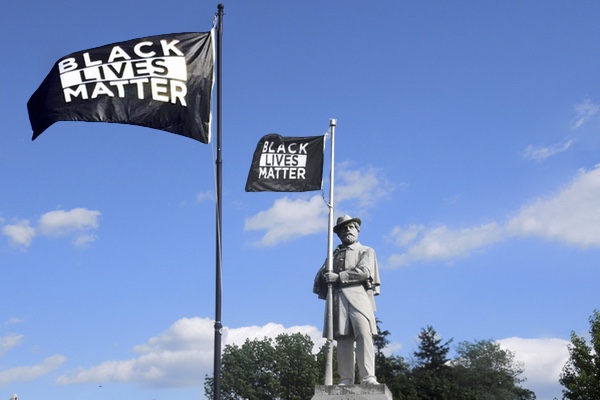What Can We Do About Those Confederate Monuments: A Proposal

Click HERE for our full coverage of the debate over John Kelly's defense of Robert E. Lee
Events at Charlottesville, Virginia, last August drew the nation’s attention to statues and monuments commemorating Confederate heroes. Currently, over 700 such memorials litter our public streets, parks, and campuses. They are a national embarrassment, indicating a profound lack of empathy for those whose ancestors suffered under slavery.
 Defenders
of the statues believed they represent “heritage.” In a sense,
that is correct: they evoke a heritage of hatred. A growing number
of people believe that things must change. But what is to be done?
Defenders
of the statues believed they represent “heritage.” In a sense,
that is correct: they evoke a heritage of hatred. A growing number
of people believe that things must change. But what is to be done?
One suggestion has been to leave the monuments in place while adding interpretive plaques that would place the statues in their proper historical context. This poses a problem: who would write such new inscriptions? Perhaps committees of academics in cooperation with community members could make the changes. Yet academic committee work too often devolves into a search for consensus. Add to that the risk-aversion of academics and local officials and the result can be bland statements of the obvious. (If you do not believe this, look at the mission statement of your local university.) Further, almost no one reads historical plaques. An enormous marble statue of a Confederate shouts a message of white supremacy; a plaque below whispers a soft rebuke to racism.
Another proposed solution has been to move Confederate monuments into museums. In theory, such facilities could offer reinterpretation of these objects. However, museum space is at a premium, making it hard to imagine just where hundreds of objects would reside.
Finding public funds to build a massive structure for statues of little artistic merit would likely be fruitless. A cheaper option would be place the statues in local historical societies. Yet it is hard to know how many small organizations across the South would effectively reinterpret the statues. Potentially, we could still end up with neo-Confederate mythology, but just moved indoors.
Here is a modest proposal. Skip the plaques and do not bother with adding to museums. Use billboards—the bigger the better—to advertise antiracist rebukes to the statues. We need to communicate as if we are on Twitter, with sharp, concise, even humorous messages.
For example, we could erect a billboard on Richmond’s Monument Avenue reading “just say no to slavery.” A giant sign at all Stone Mountain’s Confederate pantheon could read, “Friends don’t let friends commit treason.”
Most statues of Lee show him riding his massive horse, Traveler. I would like to see placards around the horse’s neck, saying, “You think I volunteered for this insanity?” Statues often depict Stonewall Jackson’s horse Little Sorrel, and his worn out old hide receives 50,000 visitors a year at the museum of the Virginia Military Institute (VMI). Little Sorrel might look good with signs reading, “I’m only here for the carrots.”
Shockingly, the rotunda at the Capitol building in Washington, D. C. still contains statues of Confederate leaders. A billboard outside the building with the slogan, “Black Lives Matter” would attract attention. Finally, big signs carrying an all-purpose declaration could accompany many statues around the country: “Sorry!” That slogan would not only convey the right message, but also use language readily understandable for Canadians.
My ideas here may seem odd; they certainly are not realistic. However, our present situation is even more absurd. When small cities, exercising local control, decide to remove offensive Confederate imagery, they risk attack from Klan members and their unsavory allies. Those statues need to go, but we face a long struggle ahead. Historians will need to patiently explain the background to today’s controversies. In the meantime, it could not hurt to advertise.